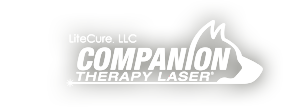Contributed by Ren Houyoux, LVT
When administering laser therapy, it is important to select the appropriate treatment head given the desired treatment technique (on or off-contact) as well as the power (wattage) selected. Here, we will discuss aspects pertinent to maximizing the effectiveness of an “off-contact” treatment delivery.
Companion Therapy Lasers all come with two flat “cone” attachments designed to be used in an off-contact treatment setting. The appropriate hover distance from the surface of the tissues is 1” to 3”. This is important to remember when we take into account the divergence (widening) of the beam. Each treatment head’s optical window has a specific divergence, and in this case both the large and small non-contact treatment heads will diverge the beam at a 47⁰ angle. Coming closer than 1” is not an appropriate technique, just as backing away more than a few inches will reduce fluence (J/cm²), and potentially expose near-field objects to the laser beam. Thus, the operator should always stay within manufacturer recommendations so as to safely and most effectively treat sites that cannot handle direct contact.
There are several advantages in being able to treat sites with which we cannot make direct contact. With this treatment technique, we are able to effectively treat open wounds, exudative lesions, sterile sites (intraoperative treatments, such as a cystotomy incision while the bladder is still exteriorized), or sites which are just too painful for the patient to allow any contact (rattlesnake envenomation, severe degloving injuries, etc.). Granted, any time we operate the laser unit without making direct contact with our target tissue, we know that there will be a certain amount of natural reflection from the surface of these tissues, but the benefit gained in these instances is greater than the disadvantage of increased energy loss.
Superficial conditions, such as hot spots, can be quite sensitive, so operating with a conservative amount of power reduces the possibility of a patient developing any sensitivity during the treatment. When using a built in protocol, the laser will automatically adjust the settings to ideal parameters for treatment. However, when operating the laser in a manual mode, utilizing a pulsed beam emission provides for thermal relaxation time to these superficial tissues, preventing any potential for thermal buildup at the surface of these tissues.
Even when treating off contact, you must still apply laser to directly exposed skin (or fur). In other words, you cannot apply laser through bandages, casts, splints, tape, etc. In order to get consistent results, we must deliver consistent treatments, and adhering to this restriction when operating in an off-contact technique is imperative.
Another important factor to take into account when treating off-contact is the possibility of a topical ointment or cream being part of the treatment plan. For example, the attending clinician may very order a topical product such as Quadritop or Silver Sulfadiazine paste for wound care. In this instance, the laser treatment should be applied without the topical agent being present. Due to the local vasodilation that occurs with photobiomodulation therapy (PBMT), as well as angiogenesis, there could be a change in the natural absorption rate of a topical product. Another concern is whether or not using a NIR beam may inactivate/potentiate, or otherwise alter the normal chemical functioning of a topical product. With these factors in mind, the operator must always ensure that PBMT treatments be done either prior to applying a topical, or that any topical be removed prior to the PBM session.
Just as with any PBMT treatment, regardless of whether we are utilizing an on-contact or off-contact technique, the operator must keep the hand piece perpendicular to the tissues being illuminated. This will ensure an even beam spot will be delivered to the tissues, and thus provide for complete and even illumination of the target tissues, delivering a therapeutic dose of energy to these sites, producing a clinically-effective treatment.
Lastly, it is also important to remember that each treatment head attachment has an ideal power range for delivery. The large non-contact hand piece attachment should be used whenever we are operating at a power higher than 3W. In this instance, we can ensure patient comfort during treatment and maximize treatment head attachment lifespan.
The on-contact treatment heads (also called deep tissue) can also be used with an off-contact technique. The advantage of this application is that the laser beam remains much more collimated with these (either 3⁰ or 13⁰, depending on whether the large {3⁰} or small {13⁰} deep tissue applicator is being utilized). This in turn enables the operator to treat a very defined site (such as an intraoperative enterotomy incision) effectively without contaminating tissues or widening the beam spot to the point where a decreased dose is delivered to the target tissues.
The Companion Therapy Lasers delivery system provides the operator with a significant amount of flexibility in being able to address various conditions effectively. One size does not fit all, and thus not one single treatment head attachment should be used for all treatments. The ability for the laser operator to choose from four different treatment heads provides a clinical efficiency in addressing a myriad of conditions and treatment design applications.




